Analysis of Sustainable Tourism Business: Parks Australia
VerifiedAdded on 2020/05/28
|13
|1808
|56
Report
AI Summary
This report examines the concept of sustainable tourism and its implementation, using Parks Australia as a case study. It explores key elements like environmental resource management, conservation, and socio-cultural respect. The report analyzes Parks Australia's objectives, operations, and outcomes, including visitor experiences, environmental impact management, and commercial arrangements. Primary data collection methods, such as online surveys and interviews, are discussed, along with performance data related to environmental management, resource efficiency, and waste reduction. The report concludes that sustainable tourism requires continuous monitoring, stakeholder engagement, and effective policy implementation to optimize socio-cultural and environmental benefits while mitigating negative impacts.
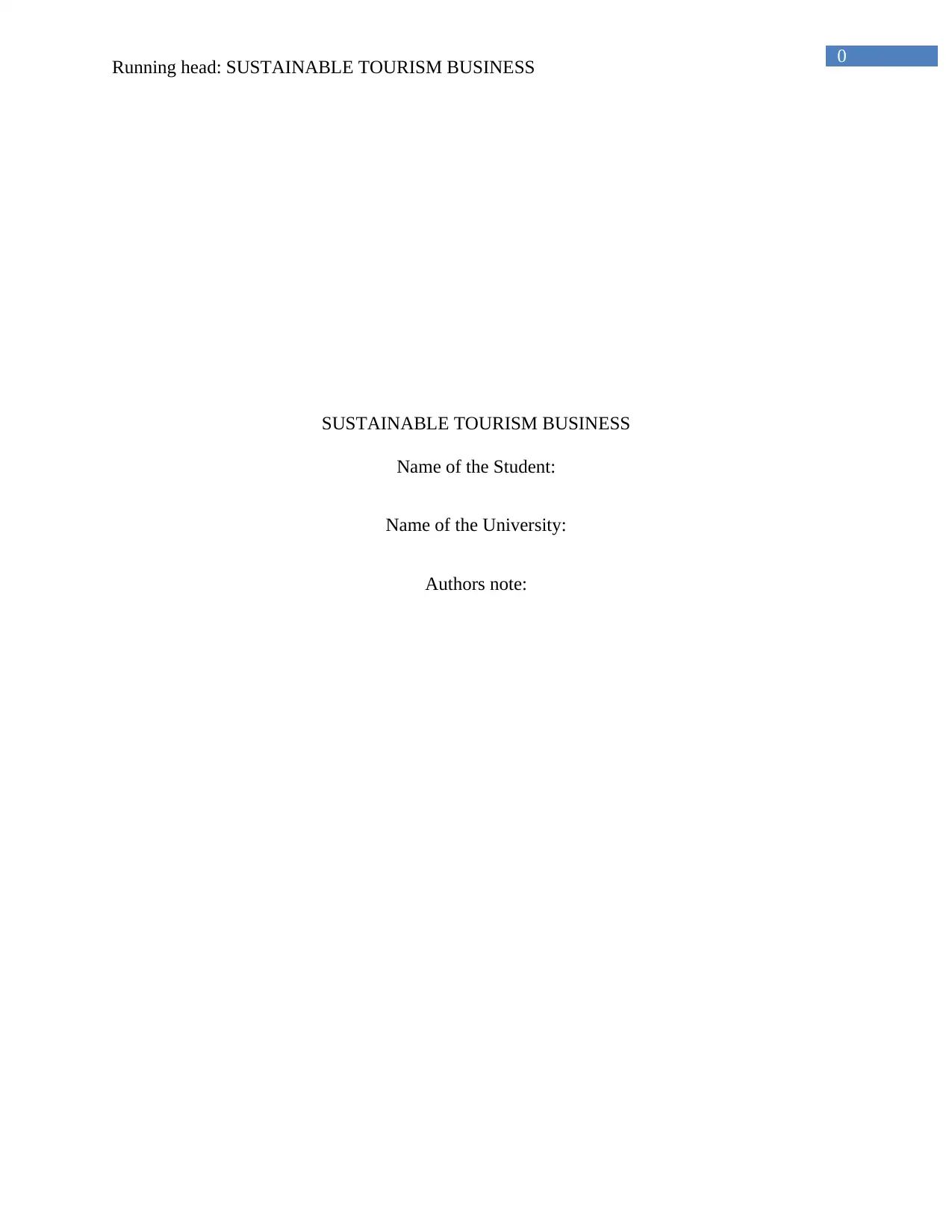
0
Running head: SUSTAINABLE TOURISM BUSINESS
SUSTAINABLE TOURISM BUSINESS
Name of the Student:
Name of the University:
Authors note:
Running head: SUSTAINABLE TOURISM BUSINESS
SUSTAINABLE TOURISM BUSINESS
Name of the Student:
Name of the University:
Authors note:
Paraphrase This Document
Need a fresh take? Get an instant paraphrase of this document with our AI Paraphraser

1
SUSTAINABLE TOURISM BUSINESS
Executive summary:
Sustainable tourism is an important concept in the recent times and is widely embraced
by planners and managers of tourist destinations. This report throws light on the implementation
of sustainable tourism business in the large cities, showing Parks Australia as an explanatory
case study. After collection of the primary data through online survey, document analysis and
semi-structured interviews, it leads to analysis of the data. This report further elaborates on the
performance of the sustainable tourism business. Furthermore, Parks Australia operations and
outcomes are also elaborated.
SUSTAINABLE TOURISM BUSINESS
Executive summary:
Sustainable tourism is an important concept in the recent times and is widely embraced
by planners and managers of tourist destinations. This report throws light on the implementation
of sustainable tourism business in the large cities, showing Parks Australia as an explanatory
case study. After collection of the primary data through online survey, document analysis and
semi-structured interviews, it leads to analysis of the data. This report further elaborates on the
performance of the sustainable tourism business. Furthermore, Parks Australia operations and
outcomes are also elaborated.

2
SUSTAINABLE TOURISM BUSINESS
Table of Contents
Introduction:....................................................................................................................................3
Background:.....................................................................................................................................3
Identification of key elements:........................................................................................................4
Objectives:.......................................................................................................................................5
Operation and outcomes:.................................................................................................................6
Primary data:....................................................................................................................................8
Performance data:............................................................................................................................9
Conclusion:....................................................................................................................................11
References:....................................................................................................................................12
SUSTAINABLE TOURISM BUSINESS
Table of Contents
Introduction:....................................................................................................................................3
Background:.....................................................................................................................................3
Identification of key elements:........................................................................................................4
Objectives:.......................................................................................................................................5
Operation and outcomes:.................................................................................................................6
Primary data:....................................................................................................................................8
Performance data:............................................................................................................................9
Conclusion:....................................................................................................................................11
References:....................................................................................................................................12
⊘ This is a preview!⊘
Do you want full access?
Subscribe today to unlock all pages.

Trusted by 1+ million students worldwide
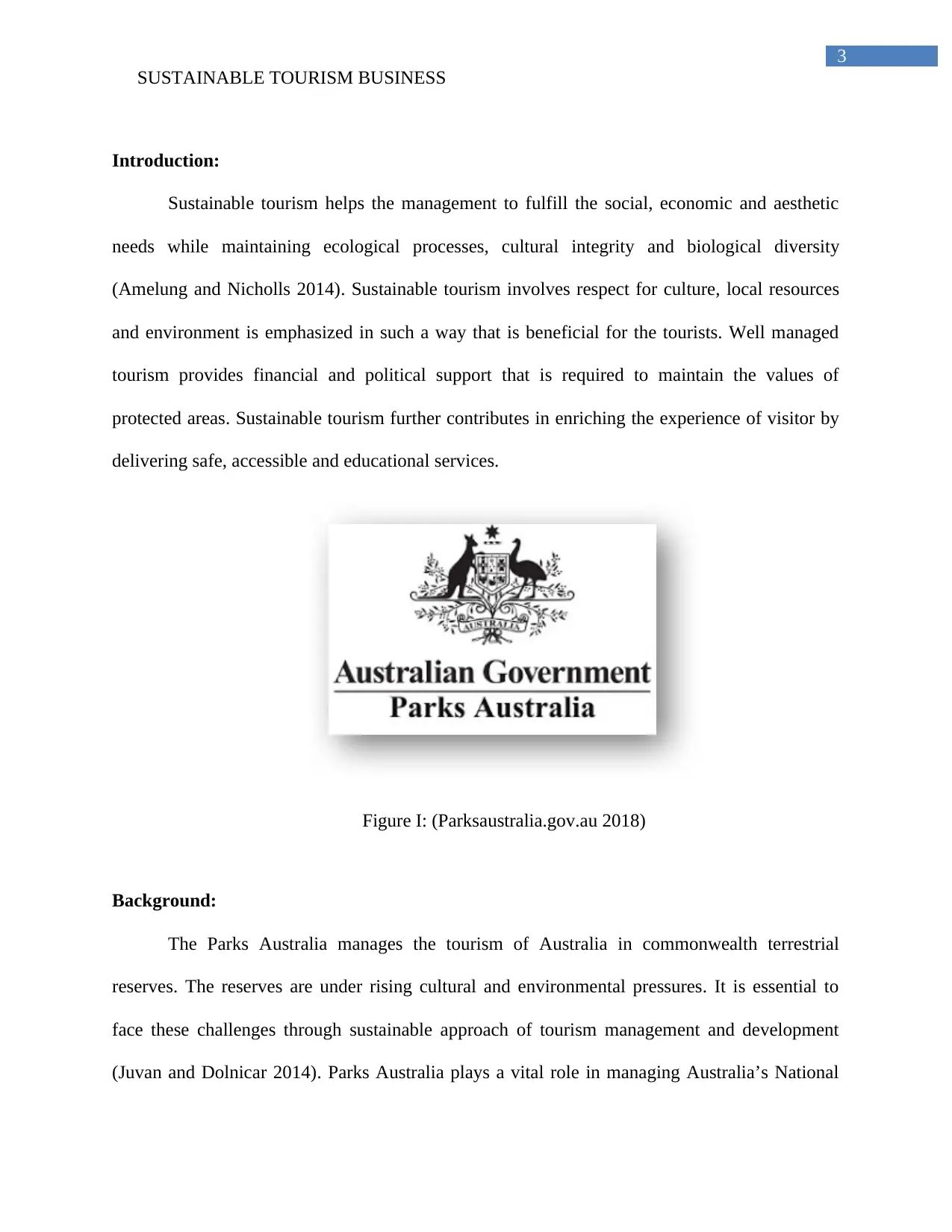
3
SUSTAINABLE TOURISM BUSINESS
Introduction:
Sustainable tourism helps the management to fulfill the social, economic and aesthetic
needs while maintaining ecological processes, cultural integrity and biological diversity
(Amelung and Nicholls 2014). Sustainable tourism involves respect for culture, local resources
and environment is emphasized in such a way that is beneficial for the tourists. Well managed
tourism provides financial and political support that is required to maintain the values of
protected areas. Sustainable tourism further contributes in enriching the experience of visitor by
delivering safe, accessible and educational services.
Figure I: (Parksaustralia.gov.au 2018)
Background:
The Parks Australia manages the tourism of Australia in commonwealth terrestrial
reserves. The reserves are under rising cultural and environmental pressures. It is essential to
face these challenges through sustainable approach of tourism management and development
(Juvan and Dolnicar 2014). Parks Australia plays a vital role in managing Australia’s National
SUSTAINABLE TOURISM BUSINESS
Introduction:
Sustainable tourism helps the management to fulfill the social, economic and aesthetic
needs while maintaining ecological processes, cultural integrity and biological diversity
(Amelung and Nicholls 2014). Sustainable tourism involves respect for culture, local resources
and environment is emphasized in such a way that is beneficial for the tourists. Well managed
tourism provides financial and political support that is required to maintain the values of
protected areas. Sustainable tourism further contributes in enriching the experience of visitor by
delivering safe, accessible and educational services.
Figure I: (Parksaustralia.gov.au 2018)
Background:
The Parks Australia manages the tourism of Australia in commonwealth terrestrial
reserves. The reserves are under rising cultural and environmental pressures. It is essential to
face these challenges through sustainable approach of tourism management and development
(Juvan and Dolnicar 2014). Parks Australia plays a vital role in managing Australia’s National
Paraphrase This Document
Need a fresh take? Get an instant paraphrase of this document with our AI Paraphraser

4
SUSTAINABLE TOURISM BUSINESS
Landscape by building its partnership with Tourism Australia. The business operates constantly
in a dynamic environment that faces new management and conservation challenges competing
for existing resources and funding. Parks Australia has the responsibility of conserving its special
places besides providing a memorable visitor experiences. Tourism is an important part of Parks
Australia contributing million in revenue by providing visitor and cultural centers, bushwalking
tracks, camping areas, roads viewing areas and 4WD tracks (Parksaustralia.gov.au 2018).
Identification of key elements:
Make adequate use of the environmental resources, which constitutes a vital element in
development of tourism and maintaining the ecological processes.
Conserve the natural habitat, biodiversity and national heritage.
Ensures development of tourism at both community and environmental level.
Respect the host community’s socio-cultural authenticity (Ruhanen et al. 2014).
Contribution towards inter-cultural understanding and its tolerance.
Providing socio-economic facilities to all the existing stakeholders.
Meeting both profitability and viability in the long run.
SUSTAINABLE TOURISM BUSINESS
Landscape by building its partnership with Tourism Australia. The business operates constantly
in a dynamic environment that faces new management and conservation challenges competing
for existing resources and funding. Parks Australia has the responsibility of conserving its special
places besides providing a memorable visitor experiences. Tourism is an important part of Parks
Australia contributing million in revenue by providing visitor and cultural centers, bushwalking
tracks, camping areas, roads viewing areas and 4WD tracks (Parksaustralia.gov.au 2018).
Identification of key elements:
Make adequate use of the environmental resources, which constitutes a vital element in
development of tourism and maintaining the ecological processes.
Conserve the natural habitat, biodiversity and national heritage.
Ensures development of tourism at both community and environmental level.
Respect the host community’s socio-cultural authenticity (Ruhanen et al. 2014).
Contribution towards inter-cultural understanding and its tolerance.
Providing socio-economic facilities to all the existing stakeholders.
Meeting both profitability and viability in the long run.

5
SUSTAINABLE TOURISM BUSINESS
Figure II: (Juvan and Dolnicar 2014)
Objectives:
Parks Australia implements management strategies for sustainable tourism by addressing
the following objectives:
Providing high quality visitor experiences and raising awareness about the cultural and natural
values of the Commonwealth reserves- As the technology is changing rapidly, it is important to
provide high quality experiences to the visitors through innovative and new ways of
communication. The visitors are accessed to diverse range of experiences that promote insight of
the reserves cultural and natural values.
Manage the visitor impacts on the cultural and natural values of Commonwealth reserves-
Growth in the demand for indigenous and nature based tourism experience put pressure on the
Commonwealth reserves. Therefore care is needed in planning recreation and tourism to lower
the negative cultural and environmental impacts according to the staff, Bessie Coleman of Parks
SUSTAINABLE TOURISM BUSINESS
Figure II: (Juvan and Dolnicar 2014)
Objectives:
Parks Australia implements management strategies for sustainable tourism by addressing
the following objectives:
Providing high quality visitor experiences and raising awareness about the cultural and natural
values of the Commonwealth reserves- As the technology is changing rapidly, it is important to
provide high quality experiences to the visitors through innovative and new ways of
communication. The visitors are accessed to diverse range of experiences that promote insight of
the reserves cultural and natural values.
Manage the visitor impacts on the cultural and natural values of Commonwealth reserves-
Growth in the demand for indigenous and nature based tourism experience put pressure on the
Commonwealth reserves. Therefore care is needed in planning recreation and tourism to lower
the negative cultural and environmental impacts according to the staff, Bessie Coleman of Parks
⊘ This is a preview!⊘
Do you want full access?
Subscribe today to unlock all pages.

Trusted by 1+ million students worldwide
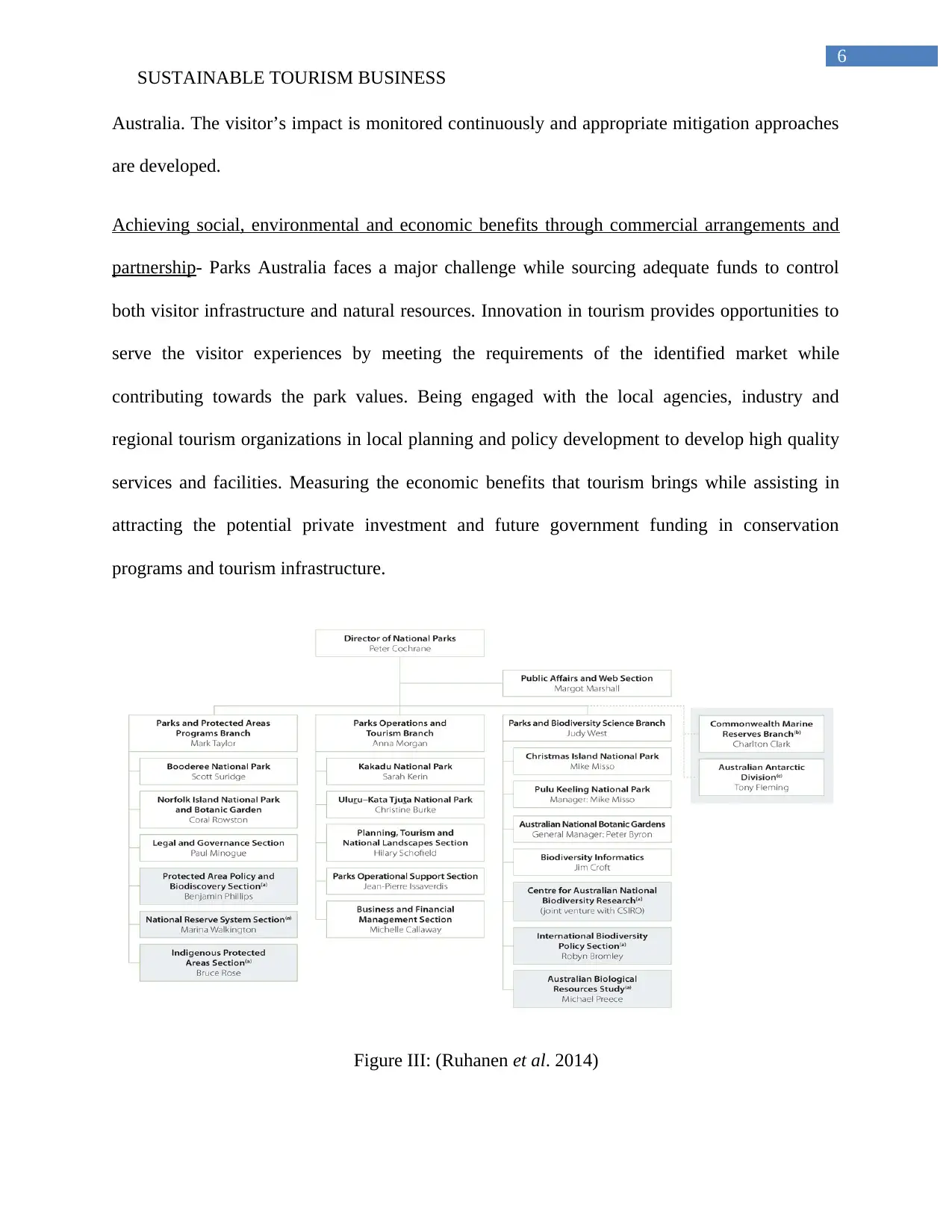
6
SUSTAINABLE TOURISM BUSINESS
Australia. The visitor’s impact is monitored continuously and appropriate mitigation approaches
are developed.
Achieving social, environmental and economic benefits through commercial arrangements and
partnership- Parks Australia faces a major challenge while sourcing adequate funds to control
both visitor infrastructure and natural resources. Innovation in tourism provides opportunities to
serve the visitor experiences by meeting the requirements of the identified market while
contributing towards the park values. Being engaged with the local agencies, industry and
regional tourism organizations in local planning and policy development to develop high quality
services and facilities. Measuring the economic benefits that tourism brings while assisting in
attracting the potential private investment and future government funding in conservation
programs and tourism infrastructure.
Figure III: (Ruhanen et al. 2014)
SUSTAINABLE TOURISM BUSINESS
Australia. The visitor’s impact is monitored continuously and appropriate mitigation approaches
are developed.
Achieving social, environmental and economic benefits through commercial arrangements and
partnership- Parks Australia faces a major challenge while sourcing adequate funds to control
both visitor infrastructure and natural resources. Innovation in tourism provides opportunities to
serve the visitor experiences by meeting the requirements of the identified market while
contributing towards the park values. Being engaged with the local agencies, industry and
regional tourism organizations in local planning and policy development to develop high quality
services and facilities. Measuring the economic benefits that tourism brings while assisting in
attracting the potential private investment and future government funding in conservation
programs and tourism infrastructure.
Figure III: (Ruhanen et al. 2014)
Paraphrase This Document
Need a fresh take? Get an instant paraphrase of this document with our AI Paraphraser
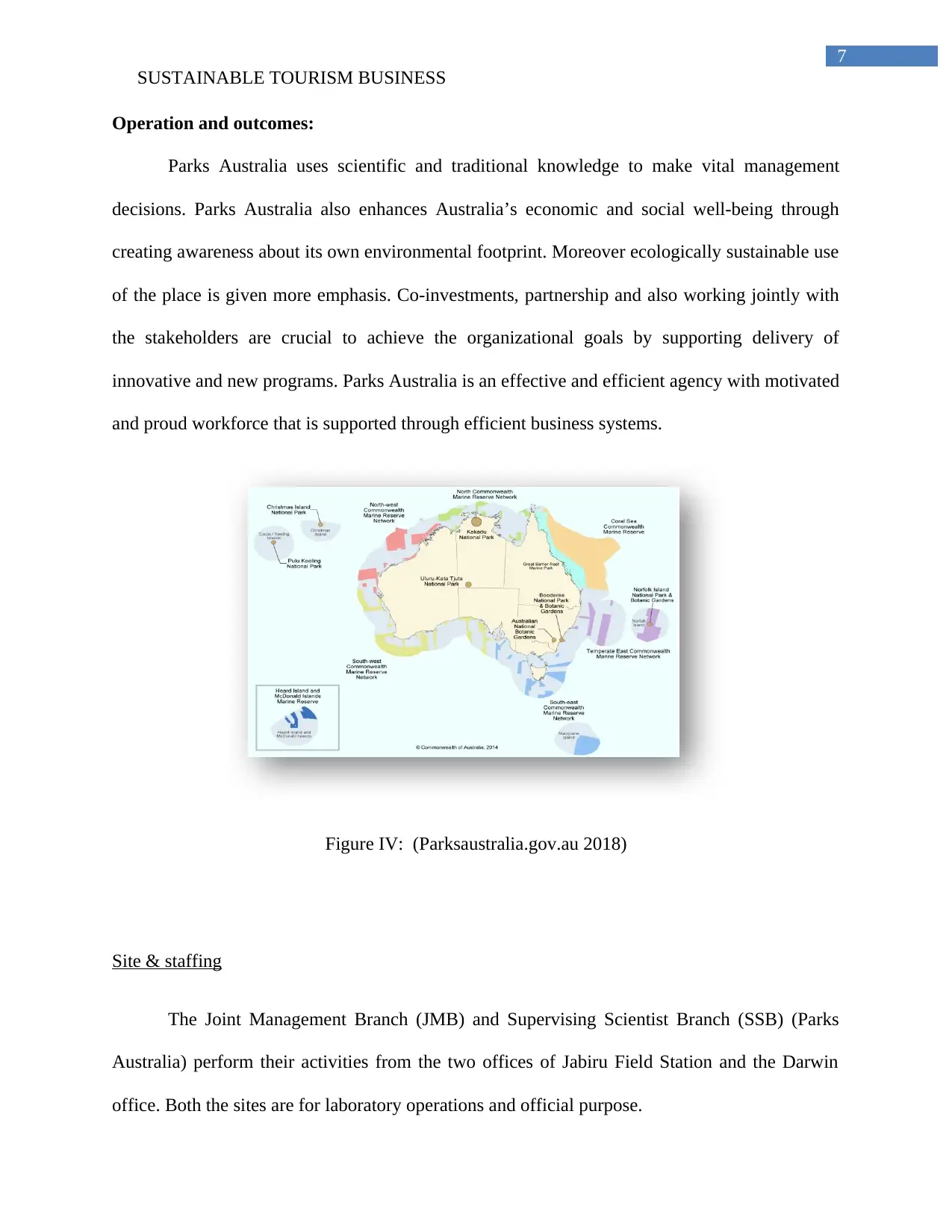
7
SUSTAINABLE TOURISM BUSINESS
Operation and outcomes:
Parks Australia uses scientific and traditional knowledge to make vital management
decisions. Parks Australia also enhances Australia’s economic and social well-being through
creating awareness about its own environmental footprint. Moreover ecologically sustainable use
of the place is given more emphasis. Co-investments, partnership and also working jointly with
the stakeholders are crucial to achieve the organizational goals by supporting delivery of
innovative and new programs. Parks Australia is an effective and efficient agency with motivated
and proud workforce that is supported through efficient business systems.
Figure IV: (Parksaustralia.gov.au 2018)
Site & staffing
The Joint Management Branch (JMB) and Supervising Scientist Branch (SSB) (Parks
Australia) perform their activities from the two offices of Jabiru Field Station and the Darwin
office. Both the sites are for laboratory operations and official purpose.
SUSTAINABLE TOURISM BUSINESS
Operation and outcomes:
Parks Australia uses scientific and traditional knowledge to make vital management
decisions. Parks Australia also enhances Australia’s economic and social well-being through
creating awareness about its own environmental footprint. Moreover ecologically sustainable use
of the place is given more emphasis. Co-investments, partnership and also working jointly with
the stakeholders are crucial to achieve the organizational goals by supporting delivery of
innovative and new programs. Parks Australia is an effective and efficient agency with motivated
and proud workforce that is supported through efficient business systems.
Figure IV: (Parksaustralia.gov.au 2018)
Site & staffing
The Joint Management Branch (JMB) and Supervising Scientist Branch (SSB) (Parks
Australia) perform their activities from the two offices of Jabiru Field Station and the Darwin
office. Both the sites are for laboratory operations and official purpose.
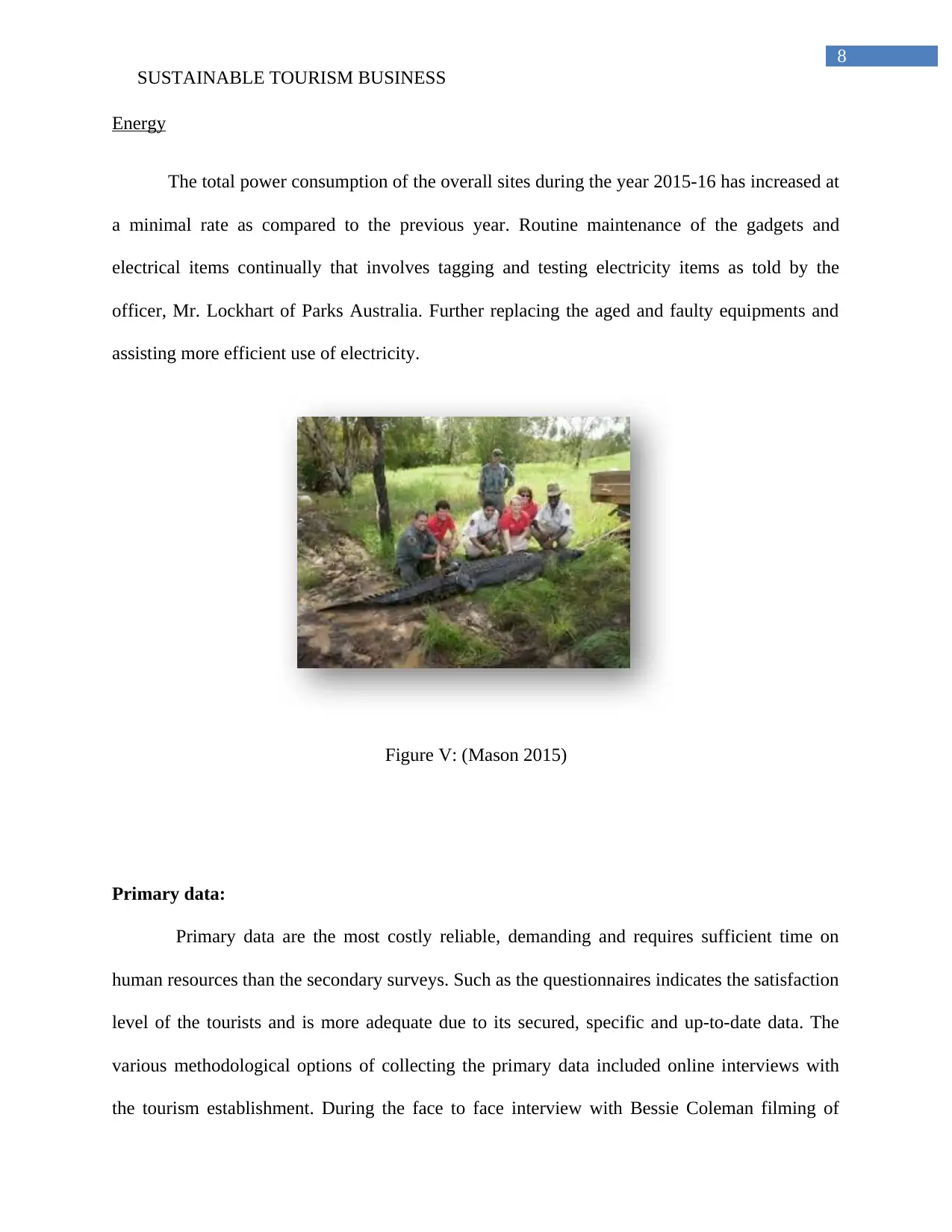
8
SUSTAINABLE TOURISM BUSINESS
Energy
The total power consumption of the overall sites during the year 2015-16 has increased at
a minimal rate as compared to the previous year. Routine maintenance of the gadgets and
electrical items continually that involves tagging and testing electricity items as told by the
officer, Mr. Lockhart of Parks Australia. Further replacing the aged and faulty equipments and
assisting more efficient use of electricity.
Figure V: (Mason 2015)
Primary data:
Primary data are the most costly reliable, demanding and requires sufficient time on
human resources than the secondary surveys. Such as the questionnaires indicates the satisfaction
level of the tourists and is more adequate due to its secured, specific and up-to-date data. The
various methodological options of collecting the primary data included online interviews with
the tourism establishment. During the face to face interview with Bessie Coleman filming of
SUSTAINABLE TOURISM BUSINESS
Energy
The total power consumption of the overall sites during the year 2015-16 has increased at
a minimal rate as compared to the previous year. Routine maintenance of the gadgets and
electrical items continually that involves tagging and testing electricity items as told by the
officer, Mr. Lockhart of Parks Australia. Further replacing the aged and faulty equipments and
assisting more efficient use of electricity.
Figure V: (Mason 2015)
Primary data:
Primary data are the most costly reliable, demanding and requires sufficient time on
human resources than the secondary surveys. Such as the questionnaires indicates the satisfaction
level of the tourists and is more adequate due to its secured, specific and up-to-date data. The
various methodological options of collecting the primary data included online interviews with
the tourism establishment. During the face to face interview with Bessie Coleman filming of
⊘ This is a preview!⊘
Do you want full access?
Subscribe today to unlock all pages.

Trusted by 1+ million students worldwide
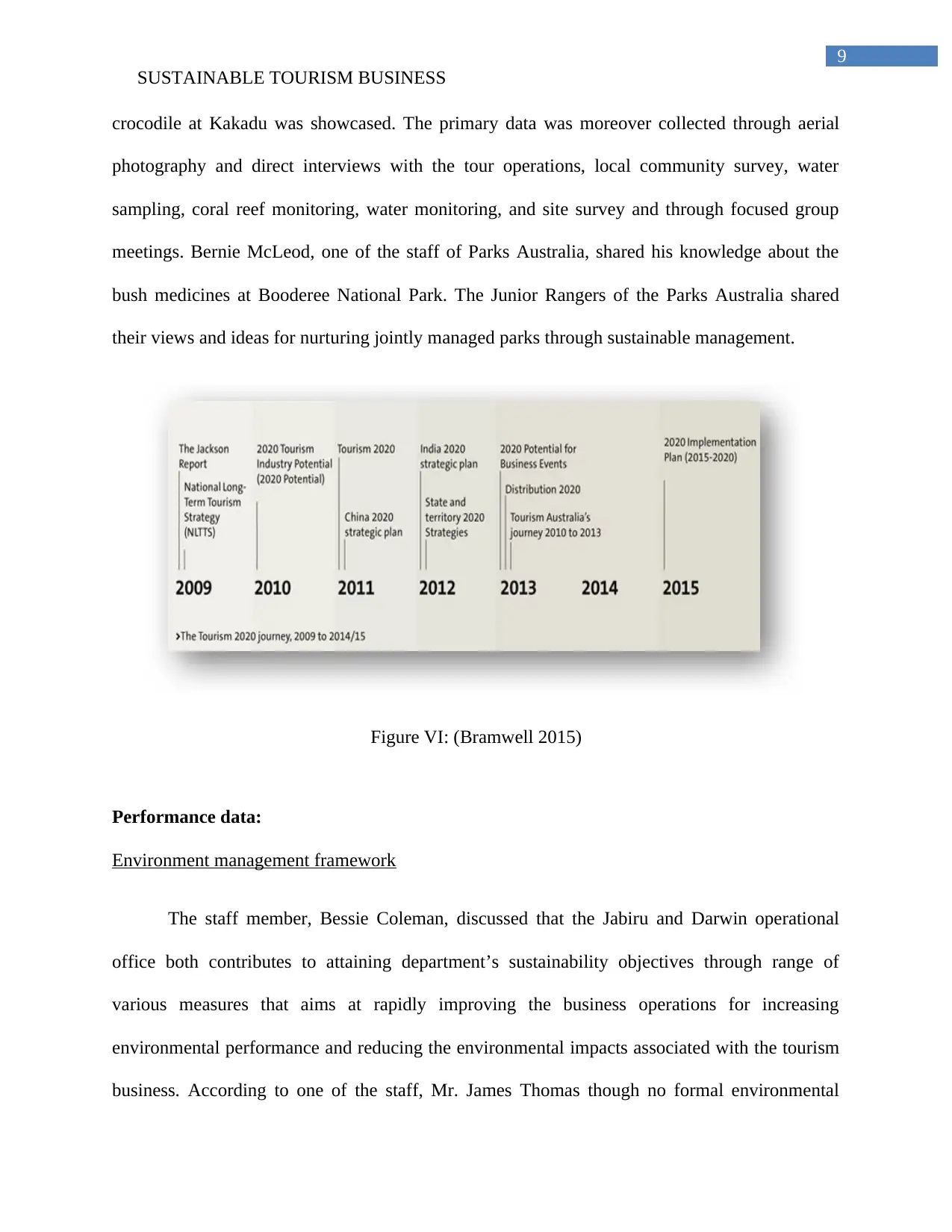
9
SUSTAINABLE TOURISM BUSINESS
crocodile at Kakadu was showcased. The primary data was moreover collected through aerial
photography and direct interviews with the tour operations, local community survey, water
sampling, coral reef monitoring, water monitoring, and site survey and through focused group
meetings. Bernie McLeod, one of the staff of Parks Australia, shared his knowledge about the
bush medicines at Booderee National Park. The Junior Rangers of the Parks Australia shared
their views and ideas for nurturing jointly managed parks through sustainable management.
Figure VI: (Bramwell 2015)
Performance data:
Environment management framework
The staff member, Bessie Coleman, discussed that the Jabiru and Darwin operational
office both contributes to attaining department’s sustainability objectives through range of
various measures that aims at rapidly improving the business operations for increasing
environmental performance and reducing the environmental impacts associated with the tourism
business. According to one of the staff, Mr. James Thomas though no formal environmental
SUSTAINABLE TOURISM BUSINESS
crocodile at Kakadu was showcased. The primary data was moreover collected through aerial
photography and direct interviews with the tour operations, local community survey, water
sampling, coral reef monitoring, water monitoring, and site survey and through focused group
meetings. Bernie McLeod, one of the staff of Parks Australia, shared his knowledge about the
bush medicines at Booderee National Park. The Junior Rangers of the Parks Australia shared
their views and ideas for nurturing jointly managed parks through sustainable management.
Figure VI: (Bramwell 2015)
Performance data:
Environment management framework
The staff member, Bessie Coleman, discussed that the Jabiru and Darwin operational
office both contributes to attaining department’s sustainability objectives through range of
various measures that aims at rapidly improving the business operations for increasing
environmental performance and reducing the environmental impacts associated with the tourism
business. According to one of the staff, Mr. James Thomas though no formal environmental
Paraphrase This Document
Need a fresh take? Get an instant paraphrase of this document with our AI Paraphraser
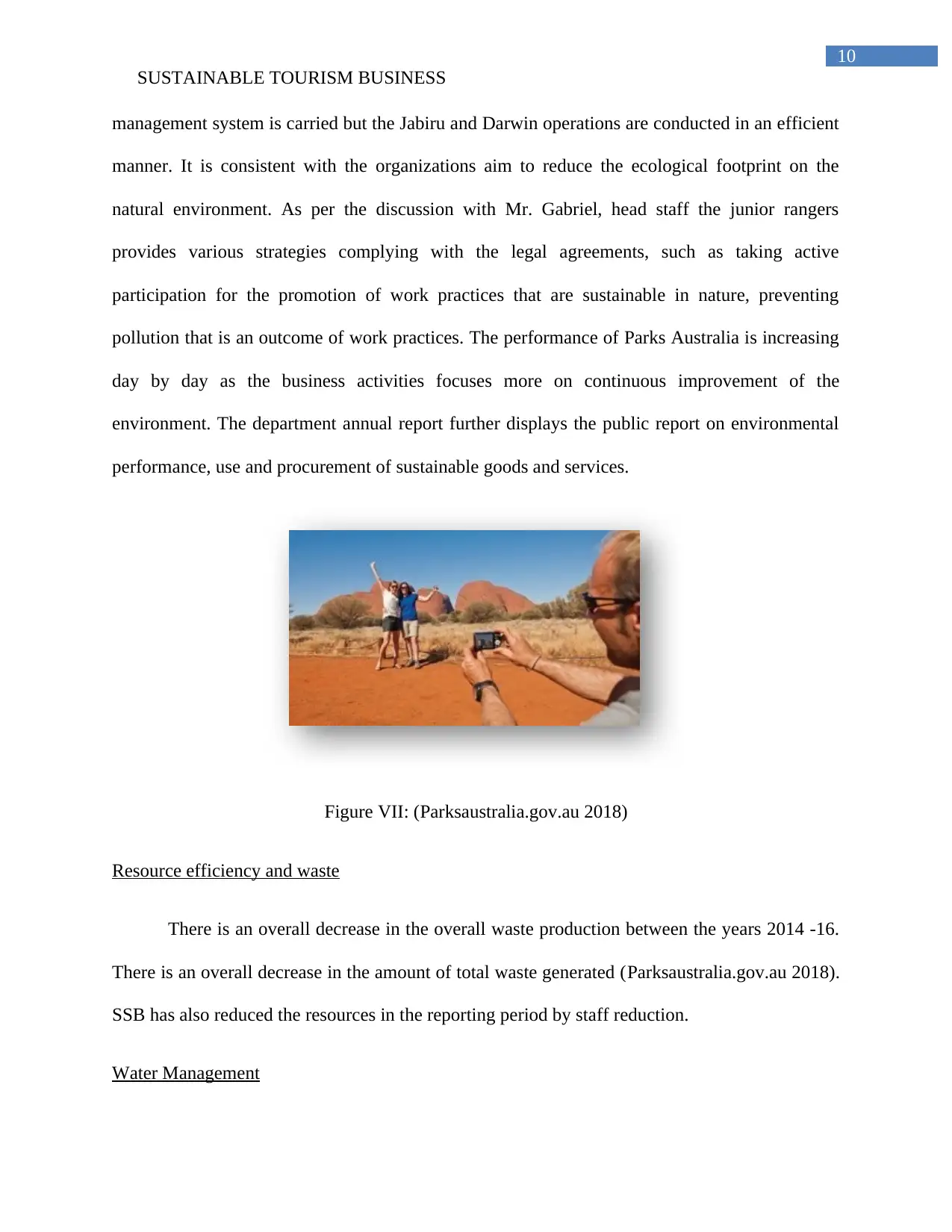
10
SUSTAINABLE TOURISM BUSINESS
management system is carried but the Jabiru and Darwin operations are conducted in an efficient
manner. It is consistent with the organizations aim to reduce the ecological footprint on the
natural environment. As per the discussion with Mr. Gabriel, head staff the junior rangers
provides various strategies complying with the legal agreements, such as taking active
participation for the promotion of work practices that are sustainable in nature, preventing
pollution that is an outcome of work practices. The performance of Parks Australia is increasing
day by day as the business activities focuses more on continuous improvement of the
environment. The department annual report further displays the public report on environmental
performance, use and procurement of sustainable goods and services.
Figure VII: (Parksaustralia.gov.au 2018)
Resource efficiency and waste
There is an overall decrease in the overall waste production between the years 2014 -16.
There is an overall decrease in the amount of total waste generated (Parksaustralia.gov.au 2018).
SSB has also reduced the resources in the reporting period by staff reduction.
Water Management
SUSTAINABLE TOURISM BUSINESS
management system is carried but the Jabiru and Darwin operations are conducted in an efficient
manner. It is consistent with the organizations aim to reduce the ecological footprint on the
natural environment. As per the discussion with Mr. Gabriel, head staff the junior rangers
provides various strategies complying with the legal agreements, such as taking active
participation for the promotion of work practices that are sustainable in nature, preventing
pollution that is an outcome of work practices. The performance of Parks Australia is increasing
day by day as the business activities focuses more on continuous improvement of the
environment. The department annual report further displays the public report on environmental
performance, use and procurement of sustainable goods and services.
Figure VII: (Parksaustralia.gov.au 2018)
Resource efficiency and waste
There is an overall decrease in the overall waste production between the years 2014 -16.
There is an overall decrease in the amount of total waste generated (Parksaustralia.gov.au 2018).
SSB has also reduced the resources in the reporting period by staff reduction.
Water Management
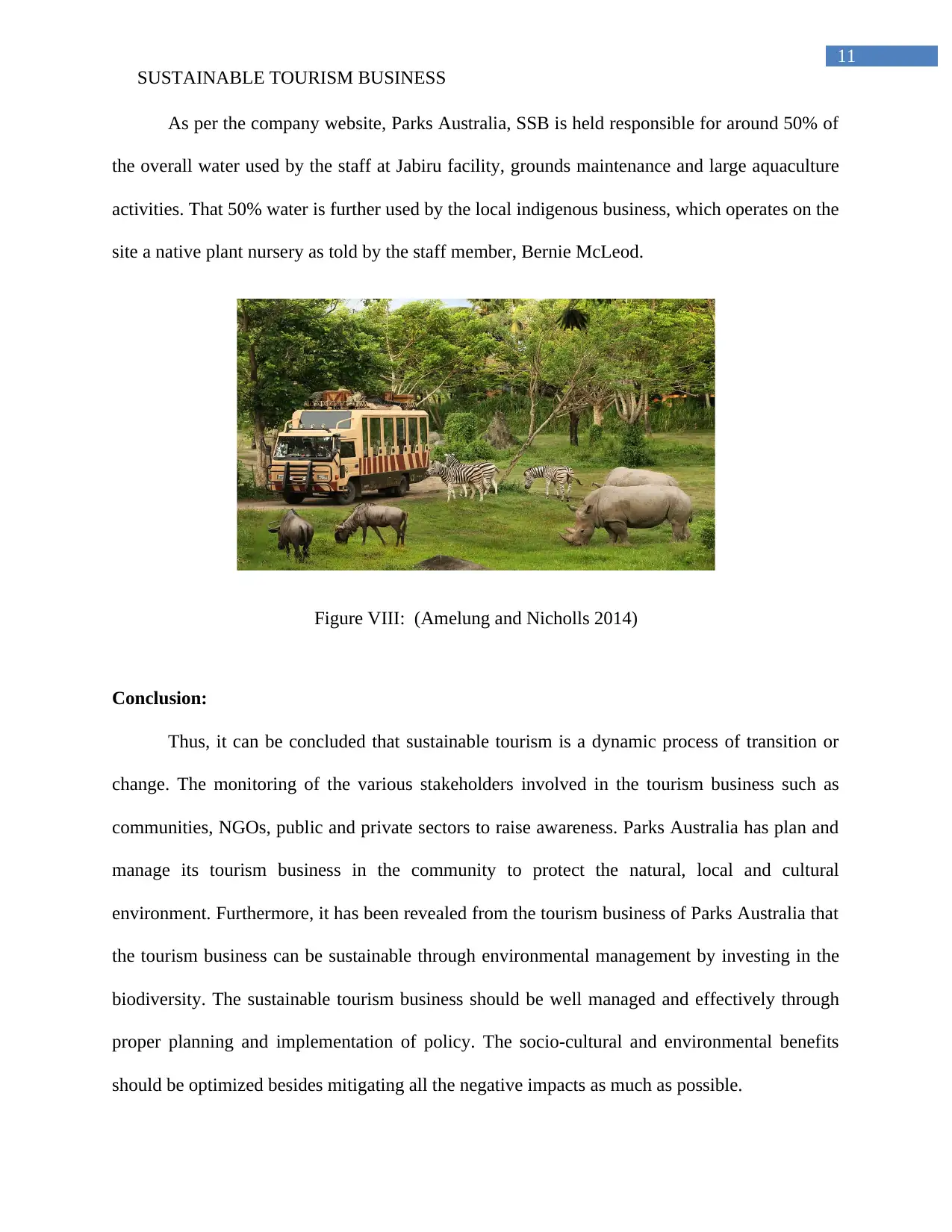
11
SUSTAINABLE TOURISM BUSINESS
As per the company website, Parks Australia, SSB is held responsible for around 50% of
the overall water used by the staff at Jabiru facility, grounds maintenance and large aquaculture
activities. That 50% water is further used by the local indigenous business, which operates on the
site a native plant nursery as told by the staff member, Bernie McLeod.
Figure VIII: (Amelung and Nicholls 2014)
Conclusion:
Thus, it can be concluded that sustainable tourism is a dynamic process of transition or
change. The monitoring of the various stakeholders involved in the tourism business such as
communities, NGOs, public and private sectors to raise awareness. Parks Australia has plan and
manage its tourism business in the community to protect the natural, local and cultural
environment. Furthermore, it has been revealed from the tourism business of Parks Australia that
the tourism business can be sustainable through environmental management by investing in the
biodiversity. The sustainable tourism business should be well managed and effectively through
proper planning and implementation of policy. The socio-cultural and environmental benefits
should be optimized besides mitigating all the negative impacts as much as possible.
SUSTAINABLE TOURISM BUSINESS
As per the company website, Parks Australia, SSB is held responsible for around 50% of
the overall water used by the staff at Jabiru facility, grounds maintenance and large aquaculture
activities. That 50% water is further used by the local indigenous business, which operates on the
site a native plant nursery as told by the staff member, Bernie McLeod.
Figure VIII: (Amelung and Nicholls 2014)
Conclusion:
Thus, it can be concluded that sustainable tourism is a dynamic process of transition or
change. The monitoring of the various stakeholders involved in the tourism business such as
communities, NGOs, public and private sectors to raise awareness. Parks Australia has plan and
manage its tourism business in the community to protect the natural, local and cultural
environment. Furthermore, it has been revealed from the tourism business of Parks Australia that
the tourism business can be sustainable through environmental management by investing in the
biodiversity. The sustainable tourism business should be well managed and effectively through
proper planning and implementation of policy. The socio-cultural and environmental benefits
should be optimized besides mitigating all the negative impacts as much as possible.
⊘ This is a preview!⊘
Do you want full access?
Subscribe today to unlock all pages.

Trusted by 1+ million students worldwide
1 out of 13
Related Documents
Your All-in-One AI-Powered Toolkit for Academic Success.
+13062052269
info@desklib.com
Available 24*7 on WhatsApp / Email
![[object Object]](/_next/static/media/star-bottom.7253800d.svg)
Unlock your academic potential
Copyright © 2020–2025 A2Z Services. All Rights Reserved. Developed and managed by ZUCOL.




